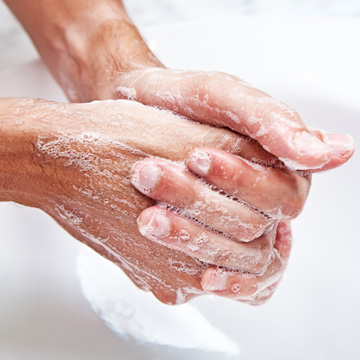There’s no cure for the common cold, but that doesn’t mean you’re defenceless. Here are some healthy habits that can reduce your risk of catching a cold-and tips on how to ease your suffering if you’re already sick.
1. Wash your hands often
Many products and practices claim to help prevent colds, but cleaning your hands remains the most effective measure. For best results, wash with soap for a minimum of 15 seconds. When sick people cough or sneeze, tiny droplets sprinkle the surfaces surrounding them with cold viruses. According to Chuck Gerba, a microbiology professor at the University of Arizona, we catch a lot of colds from touching those surfaces. “We bring our fingers to our noses or rub our eyes,” he says. “On average, adults touch their faces about 16 times an hour.” If you don’t have access to soap and water, hand sanitizers are almost as good at killing germs: they can reduce your risk of contraction by 30 to 50 per cent. Don’t rely only on sanitizer before you’re about to eat; use it when you’ve touched the copy machine at work or a bus handrail. “Viruses spread like lightning through office buildings, homes and mass transit,” Gerba says.
2. Take zinc
One dietary supplement that shows some promise in treating a cold is zinc (although further research would be helpful in tracking its effects with more certainty). “It should be in the form of a lozenge or a powder that dissolves in liquid, allowing you to swish and rub it around the inside of your mouth, as it directly binds to virus particles and inactivates them,” says Richard Nahas, medical director of Seekers Pain Centre in Ottawa and an assistant professor in the department of family medicine at the University of Ottawa. “A dose of 30 to 200 milligrams a day is safe for short-term use. Many people will likely also benefit by improving a zinc deficiency.”
3. Keep your feet warm and dry
In addition to protecting your head and neck against the chill when you venture outside, make sure your boots are warm and leak-free. Researchers at the Common Cold Centre at Cardiff University divided seemingly healthy people into two groups, believing that some would be harbouring cold viruses. Half had their feet dipped into frigid water, and that group developed significantly more colds within a three- to five-day period. “Chilling of any part of the body can do this, but the feet seem to be particularly sensitive,” says Eccles. “It’s weakening our defences and letting the virus trigger symptoms.”
4. Keep on kissing
You might be inclined to avoid kissing your partner when one of you is sick, but studies conducted over several decades have shown that kissing doesn’t transmit cold viruses. Although they’re present in the tiny droplets that leave the nose and mouth during sneezes and coughs, your mouth doesn’t harbour viruses when you aren’t forcefully coughing. When kissing a sniffly sweetheart, plant one firmly on his or her mouth, rather than pecking the cheek. As Gerba says, “You have to kiss on the lips because the other person may have touched their face with cold viruses on their hands.
5. Clean mildly
Don’t engage in an all-out assault on germs during cold season, even if a member of your household is down for the count. When wiping surfaces, use plain liquid soap; antibacterial soaps are unnecessarily aggressive. “Cleaning with a neutral detergent and a cloth will be sufficient to stop any spread,” says Nuala O’Connor, lead adviser on antibiotic resistance for the Irish College of General Practitioners. Furthermore, “if we use too many disinfectants, we’re going to encourage the development of resistant organisms.”

